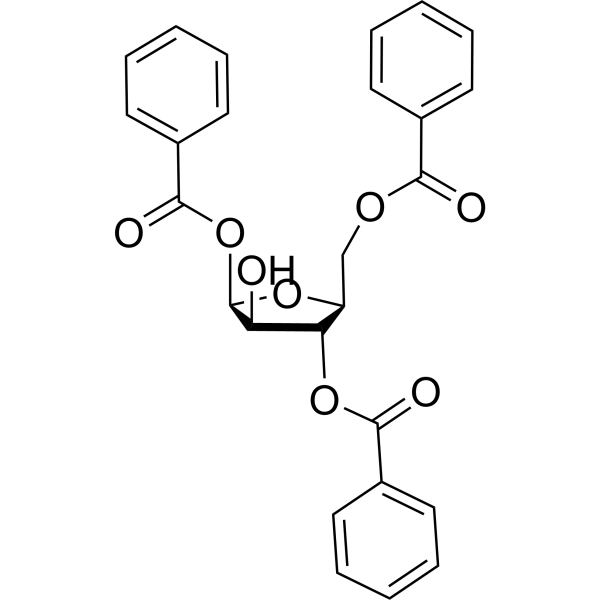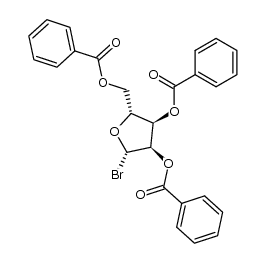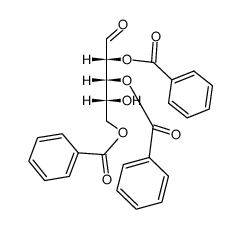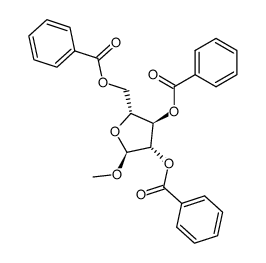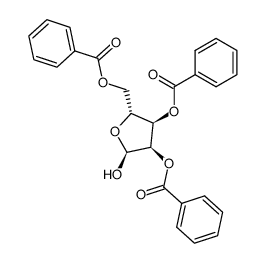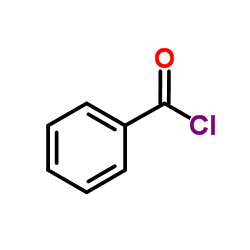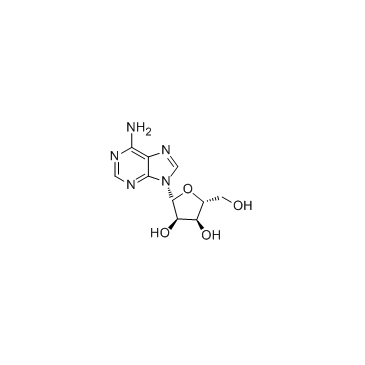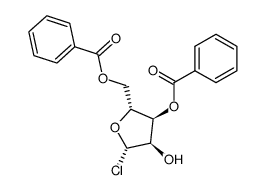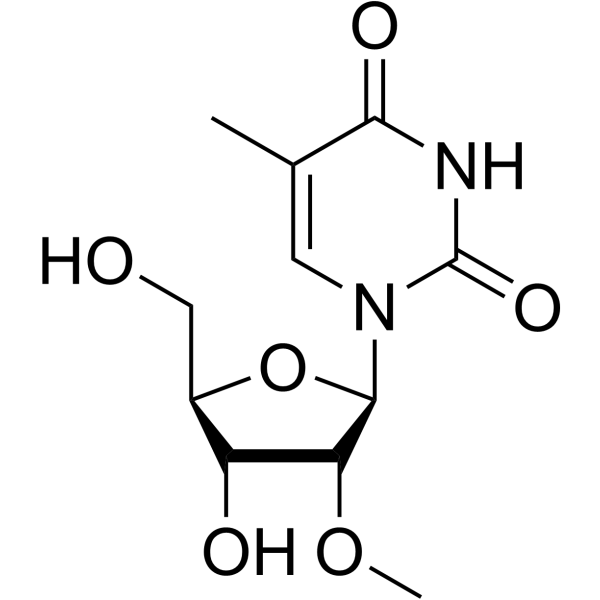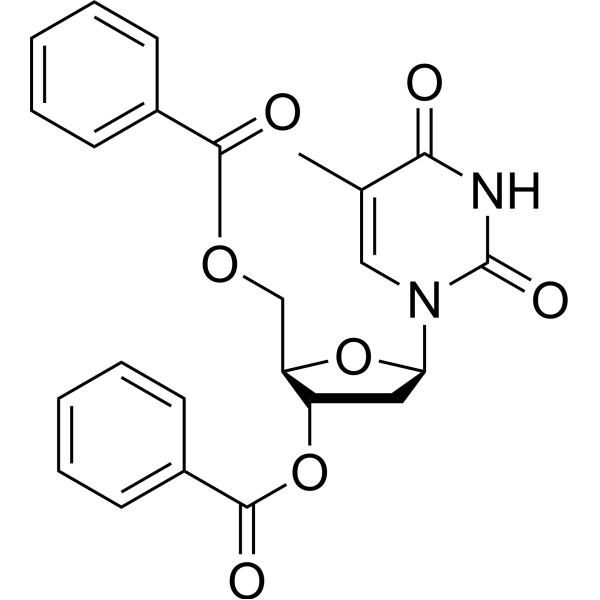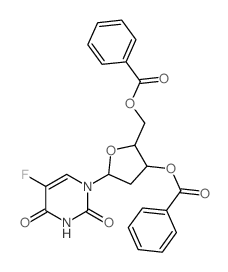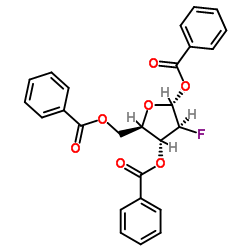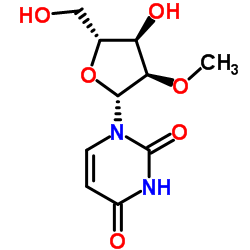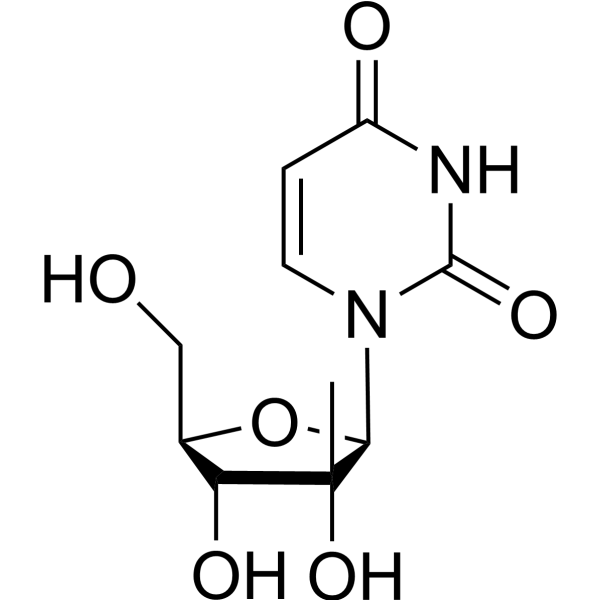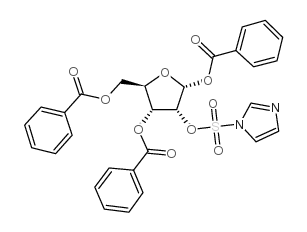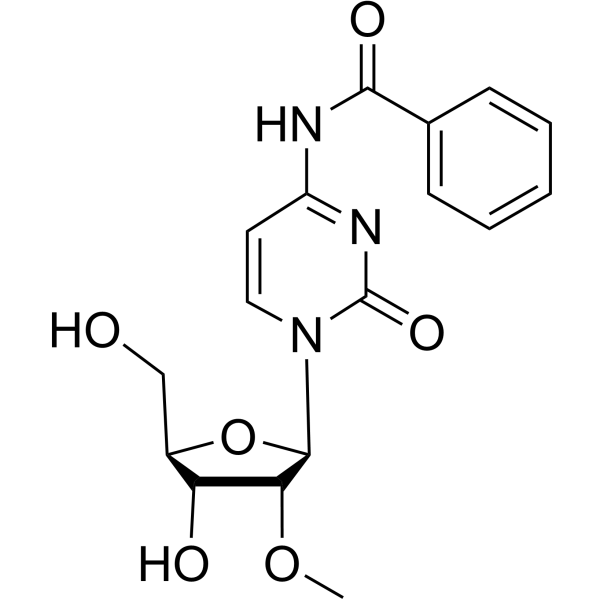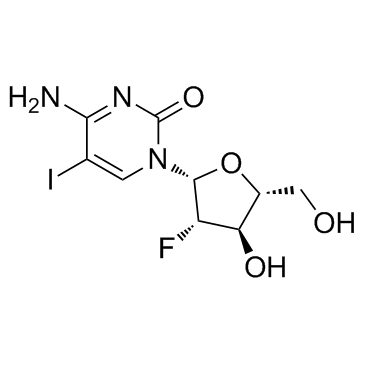22224-41-5
| 中文名 | 1,3,5-三苯甲酰基-D-呋喃核糖 |
|---|---|
| 英文名 | 1,3,5-Tri-O-benzoyl-D-ribofuranose |
| 中文别名 |
1,3,5-三-O-苯甲酰基-α-D-呋喃核糖
1,3,5-三苯甲酰基-Alpha-D-呋喃核糖 1,3,5-三苯甲酰基-α-D-呋喃核糖 |
| 英文别名 |
α-D-Ribofuranose, 1,3,5-tribenzoate
1,3,5-Tri-O-benzoyl-a-D-ribofuranose MFCD00080818 1,3,5-Tri-O-benzoyl-α-d-ribofuranose a-D-Ribofuranose,1,3,5-tribenzoate 1,3,5-TRIBENZOYL-A-D-RIBOFURANOSE 1,3,5-tribenzoate-a-D-Ribofuranose |
| 描述 | 1,3,5-三-O-苯甲酰基-a-D-呋喃核糖是嘌呤核苷类似物。嘌呤核苷类似物具有广泛的抗肿瘤活性,靶向惰性淋巴系统恶性肿瘤。这一过程中的抗癌机制依赖于抑制DNA合成、诱导细胞凋亡等[1]。 |
|---|---|
| 相关类别 | |
| 参考文献 |
| 密度 | 1.4±0.1 g/cm3 |
|---|---|
| 沸点 | 629.6±55.0 °C at 760 mmHg |
| 熔点 | 125-129 °C(lit.) |
| 分子式 | C26H22O8 |
| 分子量 | 462.45 |
| 闪点 | 213.0±25.0 °C |
| 精确质量 | 462.131470 |
| PSA | 108.36000 |
| LogP | 6.12 |
| 外观性状 | 白色至灰白色粉末或纤维状的粉末 |
| 蒸汽压 | 0.0±1.9 mmHg at 25°C |
| 折射率 | 1.633 |
| 储存条件 | 密闭,阴凉,通风干燥处 |
| 稳定性 | 常温常压下稳定 避免氧化物 |
| 分子结构 | 分子性质数据: 1、 摩尔折射率:119.93 2、 摩尔体积(m3/mol):335.7 3、 等张比容(90.2K):948.1 4、 表面张力(dyne/cm):63.5 5、 介电常数: 6、 偶极距(10 -24cm 3): 7、 极化率:47.54 |
| 更多 | 1. 性状:米黄色粉末 2. 密度(g/mL,25℃):未确定 3. 相对蒸汽密度(g/mL,空气=1):未确定 4. 熔点(ºC):125-129 5. 沸点(ºC,14mmHg):未确定 6. 沸点(ºC,5.2kPa):未确定 7. 折射率:未确定 8. 闪点(ºC):未确定 9. 比旋光度(,):[α]20/D +86±2,c =1% in chloroform 10. 自燃点或引燃温度(ºC):未确定 11. 蒸气压(mmHg,25ºC):未确定 12. 饱和蒸气压(kPa,60ºC):未确定 13. 燃烧热(KJ/mol):未确定 14. 临界温度(oC):未确定 15. 临界压力(KPa):未确定 16. 油水(辛醇/水)分配系数的对数值:未确定 17. 爆炸上限(%,V/V):未确定 18. 爆炸下限(%,V/V):未确定 19. 溶解性:未确定 |
|
1,3,5-Tri-O-benzoyl-α-D-ribofuranose
Revision number: 5
SAFETY DATA SHEET Section1. IDENTIFICATION Product name:1,3,5-Tri-O-benzoyl-α-D-ribofuranose
Revision number:5
Section2. HAZARDS IDENTIFICATION GHS classification PHYSICAL HAZARDSNot classified HEALTH HAZARDSNot classified ENVIRONMENTAL HAZARDSNot classified GHS label elements, including precautionary statements Pictograms or hazard symbolsNone Signal wordNo signal word Hazard statementsNone Precautionary statements:None Section3. COMPOSITION/INFORMATION ON INGREDIENTS Substance Substance/mixture: Components:1,3,5-Tri-O-benzoyl-α-D-ribofuranose Percent:>97.0%(LC) CAS Number:22224-41-5 Chemical Formula:C26H22O8 Section4. FIRST AID MEASURES Remove victim to fresh air and keep at rest in a position comfortable for breathing. Inhalation: Get medical advice/attention if you feel unwell. Remove/Take off immediately all contaminated clothing. Rinse skin with Skin contact: water/shower. If skin irritation or rash occurs: Get medical advice/attention. Eye contact:Rinse cautiously with water for several minutes. Remove contact lenses, if present and easy to do. Continue rinsing. If eye irritation persists: Get medical advice/attention. Ingestion:Get medical advice/attention if you feel unwell. Rinse mouth. Protection of first-aiders:A rescuer should wear personal protective equipment, such as rubber gloves and air- tight goggles. Section5. FIRE-FIGHTING MEASURES Suitable extinguishingDry chemical, foam, water spray, carbon dioxide. media: Precautions for firefighters: Fire-extinguishing work is done from the windward and the suitable fire-extinguishing method according to the surrounding situation is used. Uninvolved persons should evacuate to a safe place. In case of fire in the surroundings: Remove movable containers if safe to do so. 1,3,5-Tri-O-benzoyl-α-D-ribofuranose Section5. FIRE-FIGHTING MEASURES When extinguishing fire, be sure to wear personal protective equipment. Special protective equipment for firefighters: Section6. ACCIDENTAL RELEASE MEASURES Personal precautions,Use personal protective equipment. Keep people away from and upwind of spill/leak. protective equipment and Entry to non-involved personnel should be controlled around the leakage area by emergency procedures: roping off, etc. Environmental precautions: Prevent product from entering drains. Methods and materials for Sweep dust to collect it into an airtight container, taking care not to disperse it. containment and cleaning Adhered or collected material should be promptly disposed of, in accordance with up: appropriate laws and regulations. Section7. HANDLING AND STORAGE Precautions for safe handling Technical measures:Handling is performed in a well ventilated place. Wear suitable protective equipment. Prevent dispersion of dust. Wash hands and face thoroughly after handling. Use a local exhaust if dust or aerosol will be generated. Advice on safe handling: Avoid contact with skin, eyes and clothing. Conditions for safe storage, including any incompatibilities Storage conditions:Keep container tightly closed. Store in a refrigerator. Store away from incompatible materials such as oxidizing agents. Heat-sensitive Comply with laws. Packaging material: Section8. EXPOSURE CONTROLS / PERSONAL PROTECTION Engineering controls:Install a closed system or local exhaust as possible so that workers should not be exposed directly. Also install safety shower and eye bath. Personal protective equipment Respiratory protection: Dust respirator. Follow local and national regulations. Hand protection:Protective gloves. Eye protection:Safety glasses. A face-shield, if the situation requires. Skin and body protection: Protective clothing. Protective boots, if the situation requires. Section9. PHYSICAL AND CHEMICAL PROPERTIES Physical state (20°C):Solid Form:Crystal- Powder Colour:White - Very pale yellow Odour:No data available pH: No data available Melting point/freezing point:140°C Boiling point/range:No data available Flash point:No data available Flammability or explosive limits: Lower:No data available Upper:No data available Relative density:No data available Solubility(ies): [Water]No data available [Other solvents]No data available Section10. STABILITY AND REACTIVITY Stable under proper conditions. Chemical stability: Possibility of hazardous No special reactivity has been reported. reactions: 1,3,5-Tri-O-benzoyl-α-D-ribofuranose Section10. STABILITY AND REACTIVITY Incompatible materials: Oxidizing agents Hazardous decomposition Carbon monoxide, Carbon dioxide products: Section11. TOXICOLOGICAL INFORMATION Acute Toxicity:No data available Skin corrosion/irritation: No data available Serious eyeNo data available damage/irritation: Germ cell mutagenicity: No data available Carcinogenicity: IARC =No data available NTP =No data available Reproductive toxicity:No data available Section12. ECOLOGICAL INFORMATION Ecotoxicity: No data available Fish: Crustacea:No data available No data available Algae: Persistence / degradability: No data available No data available Bioaccumulative potential(BCF): Mobility in soil Log Pow:No data available No data available Soil adsorption (Koc): Henry's LawNo data available constant(PaM3/mol): Section13. DISPOSAL CONSIDERATIONS Recycle to process, if possible. Consult your local regional authorities. You may be able to dissolve or mix material with a combustible solvent and burn in a chemical incinerator equipped with an afterburner and scrubber system. Observe all federal, state and local regulations when disposing of the substance. Section14. TRANSPORT INFORMATION Hazards Class:Does not correspond to the classification standard of the United Nations Not listed UN-No: Section15. REGULATORY INFORMATION Safe management ordinance of dangerous chemical product (State Council announces on January 26, 2002 and revised on February 16,2011): Safe use and production, the storage of a dangerous chemical, transport, loading and unloading were prescribed. 1,3,5-Tri-O-benzoyl-α-D-ribofuranose SECTION 16 - ADDITIONAL INFORMATION N/A |
| 危害码 (欧洲) | Xi |
|---|---|
| 安全声明 (欧洲) | S22-S24/25 |
| WGK德国 | 3 |
| 上游产品 10 | |
|---|---|
| 下游产品 10 | |


